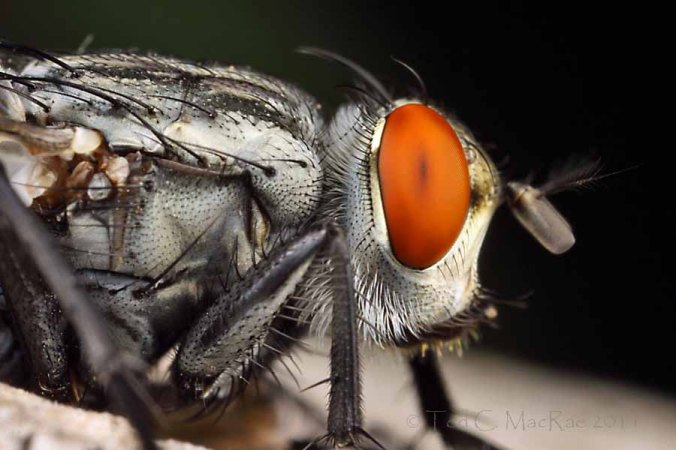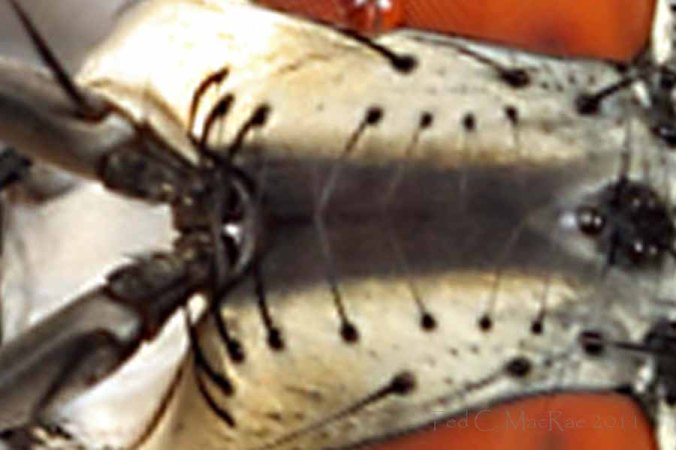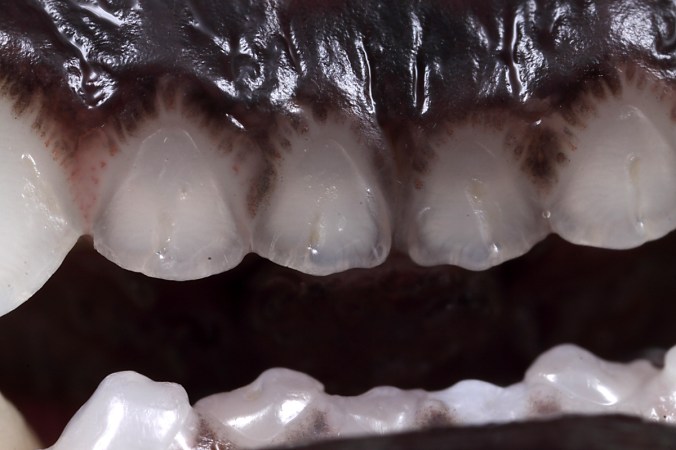
Here is the full-sized photo from which the “super-crop” featured in Super Crop Challenge #4 was taken. As many of you guessed, this is a higher fly (order Diptera, suborder Brachycera) in the family Sarcophagidae, with the photo crop showing frontal portion of the head and its associated structures. While dubbed “flesh flies” due to the necrophagic habits of a few of its included species, sarcophagids actually display diverse life histories that include a wide variety of coprophagous and parasitic species (Mulieri et al. 2010). The fly was one of the many insects I photographed in early March in Buenos Aires, Argentina at La Reserva Ecológica Costanera Sur, where it was found perched on dead wood (I found several individuals of apparently the same species perched on dead wood as well – whether this is significant or chance I don’t know).

The presence of a ptilinal fissure and lunule and a dorsal seam on the antennal pedicel identify this as one of the calyptrate “muscoid” (schizopheran to be more correct) flies. Within that group, my determination as a member of the family Sarcophagidae is based on its fairly large size, dull gray coloration with three longitudinal black strips on the mesonotum, notopleuron with two strong and two small setae (Calliphoridae have only two setae), and meron with a row of setae (lacking in Muscidae and related families). Admittedly these characters aren’t visible in the cropped photo that I presented, so guessing the proper family was a bit of a crap shoot. As noted by (de Carvalho and de Mello-Patiu 2008), species determination of sarcophagid flies is complicated by their fairly uniform chaetotaxy and lack of useful external characters, leaving male genitalia as the only reliable characters for identification. No suitable key for identifying Neotropical genera yet exists and the elaboration of one will be very difficult without analysis of the male terminalia. Dr. Luciano Patitucci (Consejo Nacional de Investigaciones Científicas y Técnicas, Buenos Aires, Argentina) suggested this is perhaps a species of Sarcophaga; however, in a recent faunal study of Sarcophagidae at the reserve, two species – Tricharaea (Sarcophagula) occidua and Oxysarcodexia varia – comprised nearly 90% of the flesh flies encountered (Mariluis et al. 2007).

A single individual is shown in the first two photos, while this mating pair was seen a little later. Although they seem to represent the same species, I can’t be certain of this, and the photo itself is not the greatest due to the female (bottom) being slightly off-focus. Nevertheless, I had to show it, because – really – who can resist photographs of fly nookie?!
REFERENCES:
de Carvalho, C. J. B. and C. A. de Mello-Patiu. 2008. Key to the adults of the most common forensic species of Diptera in South America. Revista Brasileiro de Entomologia 52(3):390–406.
Mariluis, J. C., J. A. Schnack, P. R. Mulieri and J. P. Torretta. 2007. The Sarcophagidae (Diptera) of the coastline of Buenos Aires City, Argentina. Journal of the Kansas Entomological Society 80(3):243–251.
Mulieri, P. B., J. C. Mariluis and L. D. Patitucci. 2010. Review of the Sarcophaginae (Diptera: Sarcophagidae) of Buenos Aires Province (Argentina), with a key and description of a new species. Zootaxa 2575:1–37.
Addendum:
This challenge concludes the 2nd BitB challenge session, with a record 17 participants in this final challenge. For a while it looked like HBG Dave would become our newest champion, but Session #1 champ Ben Coulter swooped in, flogged us with terminology (all of it correct and undeniable), and won two of the last three challenges to edge out Dave and, once again, take the overall victory. Make no mistake – Ben knows how to play this game! Morgan Jackson took second in this challenge and claimed the final spot on the overall podium, while Troy Barlett and newcomer Heath Blackmon tied for third. Other strong contenders during Session #2 included JasonC and Tim Eisele. Ben – contact me to claim your loot (and your loot from session #1 is in the mail).
Here is the final points tally for Session #2:
Copyright © Ted C. MacRae 2011














